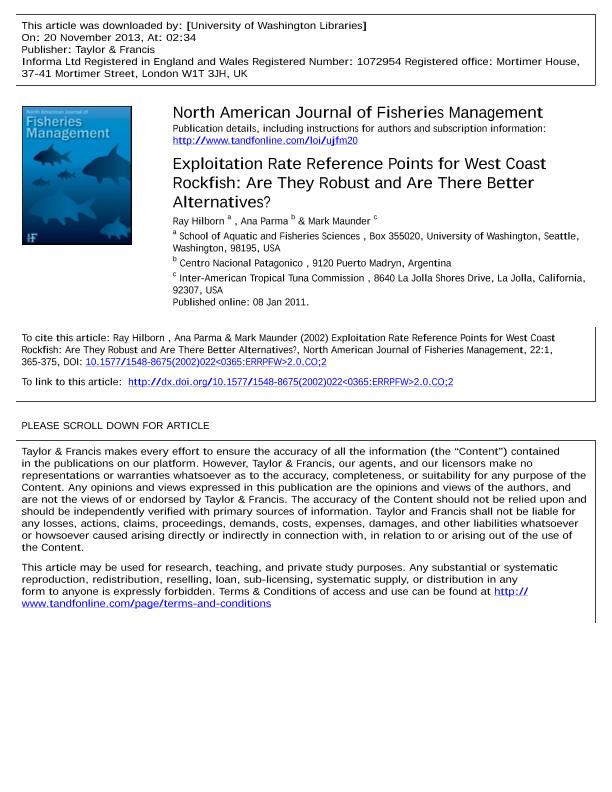Mostrar el registro sencillo del ítem
dc.contributor.author
Hilborn, Ray
dc.contributor.author
Parma, Ana María

dc.contributor.author
Maunder, Mark
dc.date.available
2020-03-18T16:41:21Z
dc.date.issued
2002-02
dc.identifier.citation
Hilborn, Ray; Parma, Ana María; Maunder, Mark; Exploitation Rate Reference Points for West Coast Rockfish: Are They Robust and Are There Better Alternatives?; American Fisheries Society; North American Journal Of Fisheries Management; 22; 1; 2-2002; 365-375
dc.identifier.issn
0275-5947
dc.identifier.uri
http://hdl.handle.net/11336/100058
dc.description.abstract
We explore several aspects of the robustness of exploitation rate reference points as a management tool. The spawner- recruit curve is an important consideration when developing exploitation rate reference points. The spawner-recruit curves for West Coast rockfish Sebastes spp. suggest low productivity compared with other tocks, but our ability to produce reliable estimates of productivity is hindered by the scarcity of reliable, fishery-independent surveys, the short time span of the data, high aging error, and the low exploitation levels. Implementation of reference exploitation rates usually assumes that we can estimate the absolute stock size and the ratio of current to virgin stock size. We show that management by reference exploitation rates is not robust to overestimation of stock size; in such cases, overexploited stocks will continue to be overexploited. We also show that if F55% exploitation rates (i.e., rates that reduce the spawning potential per recruit to 55% of its value in the unfished state) are used and productivity for an individual stock is comparable to that for other stocks around the world, we would unnecessarily impose catch reductions. We evaluate a management policy that seeks to maintain healthy stocks at or near current levels regardless of the absolute abundance, and we show that such a policy produces desirable results both when the stock size is overestimated and when stock productivity is underestimated. For stocks that are judged to be in need of rebuilding, current management policies seek to reduce catch to very low levels regardless of the reference point.
dc.format
application/pdf
dc.language.iso
eng
dc.publisher
American Fisheries Society

dc.rights
info:eu-repo/semantics/openAccess
dc.rights.uri
https://creativecommons.org/licenses/by-nc-sa/2.5/ar/
dc.subject
FISHERIES REFERENCE POINTS
dc.subject
ROCKFISH
dc.subject.classification
Ecología

dc.subject.classification
Ciencias Biológicas

dc.subject.classification
CIENCIAS NATURALES Y EXACTAS

dc.title
Exploitation Rate Reference Points for West Coast Rockfish: Are They Robust and Are There Better Alternatives?
dc.type
info:eu-repo/semantics/article
dc.type
info:ar-repo/semantics/artículo
dc.type
info:eu-repo/semantics/publishedVersion
dc.date.updated
2020-02-11T17:56:59Z
dc.journal.volume
22
dc.journal.number
1
dc.journal.pagination
365-375
dc.journal.pais
Estados Unidos

dc.journal.ciudad
Bethesda
dc.description.fil
Fil: Hilborn, Ray. University of Washington; Estados Unidos
dc.description.fil
Fil: Parma, Ana María. Consejo Nacional de Investigaciones Científicas y Técnicas. Centro Científico Tecnológico Conicet - Centro Nacional Patagónico; Argentina
dc.description.fil
Fil: Maunder, Mark. Inter-American Tropical Tuna Commission; Estados Unidos
dc.journal.title
North American Journal Of Fisheries Management

dc.relation.alternativeid
info:eu-repo/semantics/altIdentifier/doi/https://doi.org/10.1577/1548-8675(2002)022%3C0365:ERRPFW%3E2.0.CO;2
dc.relation.alternativeid
info:eu-repo/semantics/altIdentifier/url/https://www.tandfonline.com/doi/abs/10.1577/1548-8675%282002%29022%3C0365%3AERRPFW%3E2.0.CO%3B2
Archivos asociados
